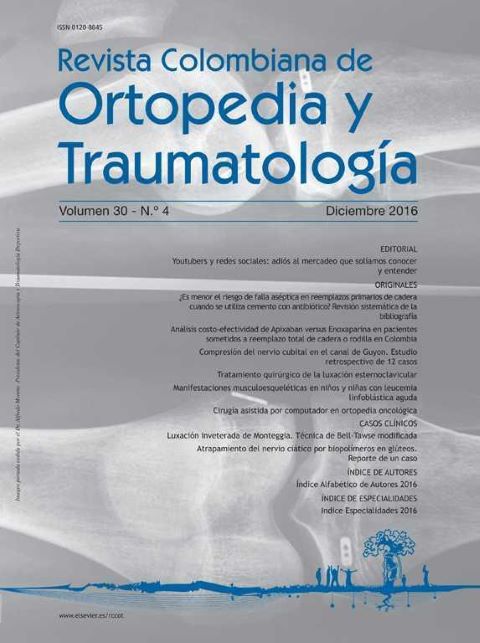¿Es menor el riesgo de falla aséptica en reemplazos primarios de cadera cuando se utiliza cemento con antibiótico? Revisión sistemática de la bibliografía
DOI:
https://doi.org/10.1016/j.rccot.2016.11.004Palabras clave:
artroplastia de cadera, cementos óseos, metilmetacrilato, aflojamiento de la prótesisResumen
Introducción: El uso de cemento con antibiótico ha demostrado disminuir el riesgo de infección periprotésica de cadera. Sin embargo, el efecto a largo plazo de agregar antibiótico al cemento continúa siendo un tema controvertido debido al posible cambio en sus propiedades mecánicas. El objetivo de este estudio es identificar el riesgo de falla aséptica a largo plazo con el uso de cemento con antibiótico en artroplastias primarias de cadera.
Metodología: Se realizó una búsqueda sistemática de la bibliografía en las bases de datos Medline, Embase y Cochrane. Se incluyeron estudios que evaluaran el riesgo de falla aséptica a largo plazo (≥10 años) en reemplazo total primario de cadera cementado, con antibiótico o sin él. La evaluación metodológica de los estudios se realizó mediante las escalas de Newcastle-Ottawa y Jadad.
Resultados: Se identificaron 5.286 títulos. Cuatro artículos fueron incluidos en el análisis: 1 experimento clínico de baja calidad y 3 cohortes prospectivas de alta calidad. En el experimento clínico no se encontraron diferencias en el riesgo de falla aséptica con el uso de cemento con antibiótico y el uso de cemento regular (p = 0,14). Además, las tres cohortes demostraron de forma coherente una reducción estadísticamente significativa (p < 0,001) en el riesgo relativo de falla aséptica a los 10 años con el uso de cemento con antibiótico.
Discusión: El uso de cemento con antibiótico para la fijación de prótesis articulares de cadera ejerce un efecto protector y disminuye el riesgo relativo de falla aséptica a largo plazo.
Nivel de evidencia clínica: Nivel II.
Descargas
Referencias bibliográficas
Wolf M, Clar H, Friesenbichler J, Schwantzer G, Bernhardt G, Gruber G, et al. Prosthetic joint infection following total hip replacement: results of one-stage versus two-stage exchange. Int Orthop. 2014;38:1363-8. https://doi.org/10.1007/s00264-014-2309-y
Sadoghi P, Schröder C, Fottner A, Steinbrück A, Betz O, Müller PE, et al. Application and survival curve of total hip arthroplasties: a systematic comparative analysis using worldwide hip arthroplasty registers. Int Orthop. 2012;36:2197-203. https://doi.org/10.1007/s00264-012-1614-6
Rogmark C, Rolfson O. Swedish Hip Arthroplasty Register. 2012.
Josefsson G, Lindberg L, Wiklander B. Systmeic antibiotics and gentamicin-containing bone cement in the prophylaxis of postoperative infections in total hip arthroplasty. Clin Orthop Relat Res. 1981;159:194-200. https://doi.org/10.1097/00003086-198109000-00027
Soares D, Leite P, Barrerira P, Aido R, Sousa R. Antibioticloaded bone cement in total joint arthroplasty. Acta Orthop Belg. 2015;81:184-90.
Wang J, Zhu C, Cheng T, Peng X, Zhang W, Qin H, et al. A systematic review and meta-analysis of antibiotic-impregnated bone cement use in primary total hip or knee arthroplasty. PLoS One. 2013;8:4-11. https://doi.org/10.1371/journal.pone.0082745
Rezapoor M, Parvizi J. Prevention of periprosthetic joint infection. J Arthroplasty. 2015;30:902-7. https://doi.org/10.1016/j.arth.2015.02.044
Espehaug B, Furnes O, Havelin LI, Engesæter LB, Vollset SE. The type of cement and failure of total hip replacements. J Bone Joint Surg Br. 2002;84-b:832-8. https://doi.org/10.1302/0301-620X.84B6.0840832
Parvizi J, Saleh KJ, Ragland PS, Pour AE, Mont MA. Efficacy of antibiotic-impregnated cement in total hip replacement. Acta Orthop. 2008;79:335-41. https://doi.org/10.1080/17453670710015229
NHS. National Institute for Health and Clinical Excellence. Total hip replacement and resurfacing artroplasty for end-stage arthritis of the hip. NICE technology appraisal guidance [TA304] February 2014. Disponible en: https://www.nice.org.uk/guidance/ta304/chapter/3-the-technologies
Johnston RC. Acrylic bone cement: Clinical development and current status in North America. Orthop Clin North Am. 2005;36:75-84. https://doi.org/10.1016/j.ocl.2004.06.005
Cummins JS, Tomek IM, Kantor SR, Furnes O, Engesaeter LB, Finlayson SRG. Cost-effectiveness of antibiotic-impregnated bone cement used in primary total hip arthroplasty. J Bone Joint Surg Am. 2009;91:634-41. https://doi.org/10.2106/JBJS.G.01029
Moher D, Liberati A, Tetzlaff J, Altman D. Preferred Reporting items for systematic reviews and meta-analyses: The PRISMA Statement (Reprinted from Annals of Internal Medicine). PLoS Med. 2009;6:1-6. https://doi.org/10.1371/journal.pmed.1000097
Block JE, Stubbs HA. Reducing the risk of deep wound infection in primary joint replacement with antibiotic bone cement. Orthopedics. 2005;28:1334-45. https://doi.org/10.3928/0147-7447-20051101-13
Phillips B, Ball C, Sackett D, Badenoch D, Straus S, Haynes B, et al. Oxford centre for evidence-based medicine levels of evidence. March 2009. Disponible en: http://www.cebm.net/oxford-centre-evidence-based-medicine-levels-evidencemarch-2009/
Wells GA, Shea B, Connell DO, Peterson J, Welch V, Losos M, et al. The Newcastle-Ottawa Scale (NOS) for assessing the quality of nonrandomised studies in meta-analyses. Disponible en: http://www.ohri.ca/programs/clinicalepidemiology/oxford.asp
Jadad AR, Moore RA, Carroll D, Jenkinson C, Reynolds DJM, Gavaghan DJ, et al. Assessing the quality of reports of randomized clinical trials: Is blinding necessary. Control Clin Trials. 1996;17:1-12. https://doi.org/10.1016/0197-2456(95)00134-4
Concato J, Shah N, Horwitz R. Randomized, controlled trials, observationas studies and the hierarchy of research designs. N Engl J Med. 2000;342:1887-92. https://doi.org/10.1056/NEJM200006223422507
Josefsson G. Prophylaxis with systematic antibiotics versus gentamicin bone cement in total hip arthroplasty: A ten-year survey of 1688 hips. Clin Orthop Relat Res. 1993;292:210-4. https://doi.org/10.1097/00003086-199307000-00026
Engesæter LB, Lie SA, Espehaug B, Furnes O, Vollset SE, Havelin LI. Antibiotic prophylaxis in total hip arthroplasty Effects of antibiotic prophylaxis systemically and in bone cement on years in the Norwegian Arthroplasty Register. Acta Orthop Scand. 2003;74:644-51. https://doi.org/10.1080/00016470310018135
Engesaeter LB, Espehaug B, Lie SA, Furnes O, Havelin LI. Does cement increase the risk of infection in primary total hip arthroplasty? Revision rates in 56,275 cemented and uncemented primary THAs followed for 0-16 years in the Norwegian Arthroplasty Register. Acta Orthop. 2006;77:351-8. https://doi.org/10.1080/17453670610046253
de Kam DCJ, Gardeniers JWM, Veth RPH, Schreurs BW. Good results with cemented total hip arthroplasty in patients between 40 and 50 years of age. Acta Orthop. 2010;81: 165-70. https://doi.org/10.3109/17453671003717831
Havelin LI, Engesaeter LB, Espehaug B, Furnes O, Lie SA, Vollset SE. The Norwegian Arthroplasty Register: 11 years and 73,000 arthroplasties. Acta Orthop Scand. 2000;71:337-53. https://doi.org/10.1080/000164700317393321
Dunbar MJ. Cemented femoral fixation: the North Atlantic divide. Orthopedics. 2009;32:662-6. https://doi.org/10.3928/01477447-20090728-07
Ebramzadeh E, Sarmiento A, McKellop HA, Llinas A, Gogan W. The cement mantle in total hip arthroplasty. Analysis of long-term radiographic results. J Bone Joint Surg Am. 1994;76: 77-87. https://doi.org/10.2106/00004623-199401000-00010
Ebramzadeh E, Normand PL, Sangiorgio SN, Llinás A, Gruen TA, McKellop HA, et al. Long-term radiographic changes in cemented total hip arthroplasty with six designs of femoral components. Biomaterials. 2003;24:3351-63. https://doi.org/10.1016/S0142-9612(03)00187-X
Klekamp J, Dawson JM, Haas DW, DeBoer D, Christie M. The use of vancomycin and tobramycin in acrylic bone cement: biomechanical effects and elution kinetics for use in joint arthroplasty. J Arthroplasty. 1999;14:339-46. https://doi.org/10.1016/S0883-5403(99)90061-X
Moran JM, Greenwald AS, Matejczyk MB. Effect of gentamicin on shear and interface strengths of bone cement. Clin Orthop Relat Res. 1979;141:96-101. https://doi.org/10.1097/00003086-197906000-00011
Santavirta S, Takagi M, Konttinen YT, Sorsa T, Suda A. Inhibitory effect of cephalothin on matrix metalloproteinase activity around loose hip prostheses. Antimicrob Agents Chemother. 1996;40:244-6. https://doi.org/10.1128/AAC.40.1.244
Descargas
Publicado
Cómo citar
Número
Sección
Licencia
Derechos de autor 2024 Revista Colombiana de ortopedia y traumatología

Esta obra está bajo una licencia Creative Commons Reconocimiento 3.0 Unported.








